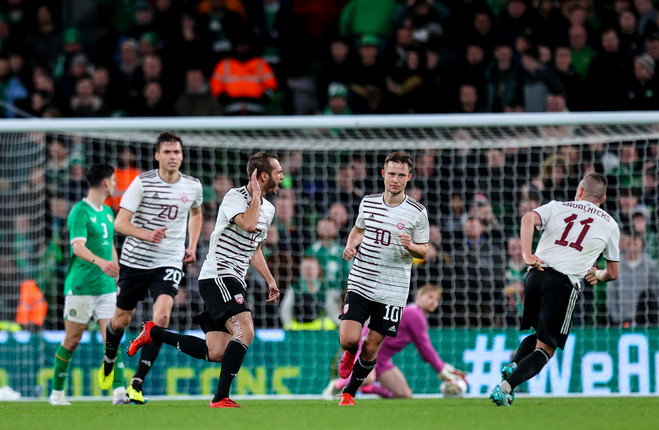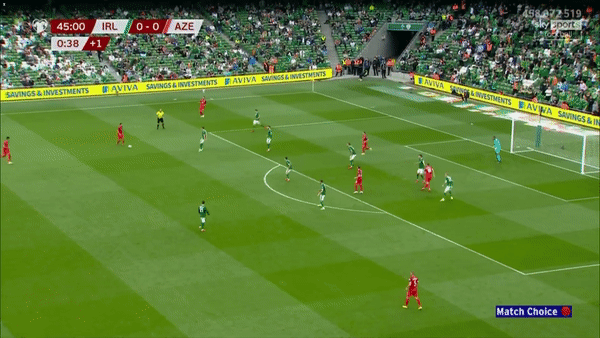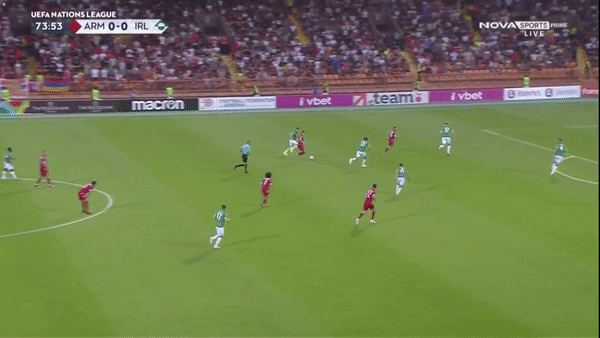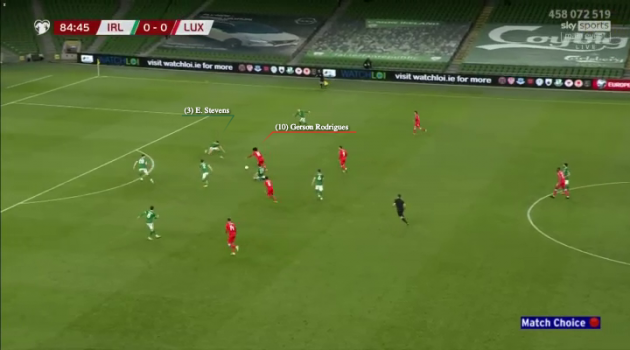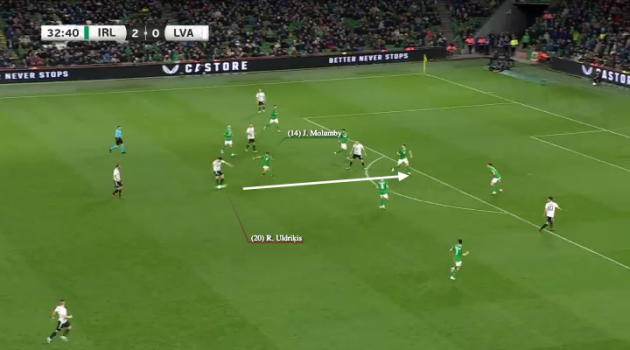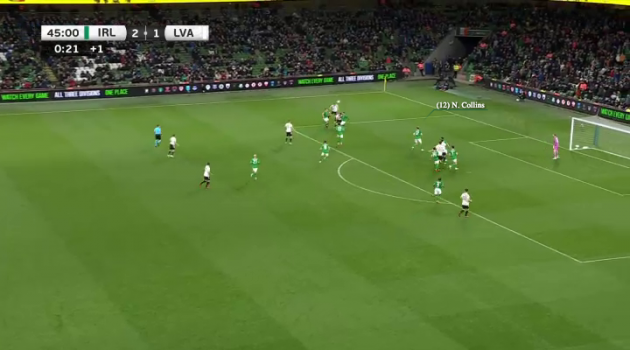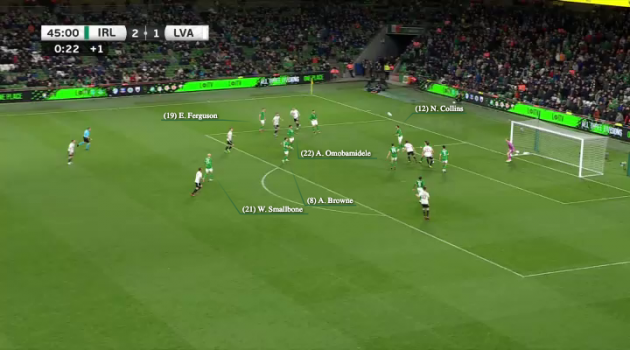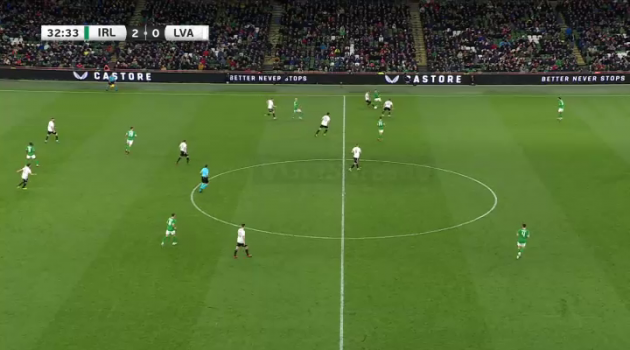LAST NIGHT’S FRIENDLY win against Latvia once again raised a baffling question: why do Ireland concede so many goals from long range?
If you’re a small nation low in the Fifa rankings, coming to Dublin is a worthwhile trip in one sense: you’ll leave with a worldie for the highlight reel.
Both of Latvia’s goals were scored from outside the box, which continues a strange trend. Since the start of 2021, Ireland have conceded 23 goals, nine of which have been scored from outside the penalty area.
No other side in European football is leaking these types of goals at such a rate. With a big thanks to Andrew Cuneen of Stats Perform: 39% of the goals Ireland have conceded have come from outside the box, which is a much higher share than the next-highest, who are Scotland, on 26%. And further to that, Ireland have faced 85 shots from outside the box in that time frame, so, on average, are conceding from every 9.4 shots they face from range.
To be conceding at this rate is a statistical freak.
And not to lay on the stats too thickly, but…
The nine goals Ireland have conceded from outside the box since the start of 2021 have an accumulated Expected Goals value of 0.42.
So that’s 0.42 Expected Goals, but nine Actual Goals.
It can’t be down to a goalkeeper problem either, given these goals have flown by Mark Travers, Gavin Bazunu and Caoimhín Kelleher.
The nine long-range goals have been:
- Aleksander Mitrovic’s chip of Mark Travers in Belgrade
- Gerson Rodrigues’ winner for Luxembourg in Dublin
- Emin Mahmudov goal for Azerbaijan in the 1-1 draw in Dublin
- Eduard Spertsyan’s winning goal for Armenia in Yerevan
- Viktor Tsyhankov’s wide free-kick for Ukraine in the 1-0 win in Dublin
- Both of Armenia’s goals in Ireland’s 3-2 win in Dublin
- Both of Latvia’s goals last night
Looking back at the clips of the goals, there is no single Irish error threading through them all, but some do share characteristics. Let’s take a look at some of them..
1) Not enough pressure on the ball
The first assumption one would reach for when confronted with this bizarre trend would be that Ireland have been giving opponents too much room to shoot. It is a fair critique of some of the goals, but not on all of them. It was more of an issue earlier in Stephen Kenny’s reign.
Here for instance, Ireland give Emin Makhmudov of Azerbaijan way too much time to shoot in what proved to be a 1-1 draw. This was all the more unforgivable given they were forewarned, as Makhmudov scored from range against Luxembourg days earlier.
Ireland also didn’t put enough pressure on Armenia’s Eduard Spertsyan for his winning goal in the Nations League game in Yerevan last summer.
There is some – but not enough – mitigation for this in the sense that it came late in the game drenched in a sticky heat and weeks after the end of the Championship season, meaning many of Ireland’s players were rusty.
Josh Cullen (wearing number six in the clip below) could definitely have done more to shuttle across.
And if you’re being very critical, Enda Stevens might have done a bit more to press Gerson Rodrigues’ shot in the defeat to Luxembourg. He jumped as if to press him only to then stand off for half a second.
But in fairness to Ireland, these issues of standing off the shooter haven’t been as prevalent in recent games.
For Latvia’s first goal last night, for instance, Jayson Molumby makes an instant attempt to press the man who ultimately assisted the goal. When the pass is popped off to Uldrikis, Molumby can’t quite get to the shot and, if we are being uber-critical, has committed slightly too much to his initial press.
2) Not defending set pieces
A couple of the long-range goals have their genesis in Ireland not properly dealing with set pieces. Most obvious is Viktor Tsyhankov goal for Ukraine in Dublin last year: it was a wide free-kick that was really a cross, but Ireland allowed it bounce in the penalty box and into the net unaided.
Not defending a set-piece properly was the cause of Latvia’s equaliser last night too. Latvia targeted the second phase of these wide free-kicks all night. In this instance, Latvia make the first contact on the edge of the box…
…but Nathan Collins has the chance to clear his lines. Rather than do so, he heads the ball back in front of him, and Andrew Omobamidele loses the next challenge.
From there: chaos and Ireland are ultimately unlucky. Dara O’Shea and Callum O’Dowda collide with eachother in trying to clear the ball, and it breaks on the edge of the box to Arturs Zjuzins. His snapshot is good, but the deflection off Collins is enough to slightly wrong-foot Kelleher.
But Ireland left themselves hostage to misfortune by not clearing their lines. Collins came up with a couple of excellent clearances late in the game when Ireland were protecting their 3-2 lead, but this was an error. This is merely theorising, but perhaps he is thinking not of hacking the ball clear, but of kickstarting potential counter-attack? There is a cluster of Ireland’s attacking players close to each other on the edge of the box who can create exactly that kind of opportunity.
And while that kind of attitude from Collins is laudable, but it is a fine margin between bravery and error. This goal proved it.
3) Ireland’s attacking shape
To build on that last point: this Irish side is set up to create goals in a way previous Irish teams were not, which does leave them susceptible on the counter-attack. It should also be noted that Ireland do not get sliced open nearly as often as they used to, as the decision to sacrifice an attacker for an extra midfielder midway through last summer’s four-game window has largely solved that problem.
But Ireland are occasionally vulnerable when they give the ball away, and three of these long-range nine goals came in transition.
The most obvious was Conor Hourihane’s terrible giveaway for Armenia’s equaliser last September: a thoughtless square pass straight to our old pal Spertsyan, who curled a shot beyond Bazunu.
Ireland’s set-up makes them slightly vulnerable in this way: when building up in possession, their midfield is a triangle, with the ‘six’ sitting behind two more advances ‘eights.’ Given their vastly-improved goalscoring record, you would say it is a worthwhile risk, and it was clear how one of those eights, Will Smallbone, contributed to the Irish attack last night.
But when attacks break down, there is a lone defensive midfielder to cover space.
That was how Latvia got a sight of goal for their opener last night: Matt Doherty lost possession in the right wing-back position, and only Ireland’s three centre-backs were behind the ball. (Collins is out of shot.)
And while Ireland gave Spertsyan too much room to shoot in Yerevan, that goal also came from an Ireland giveaway.
If Doherty had gotten his pass right above, Ireland have a very good attacking platform, with Smallbone and Ferguson close to him. Strategy in football is often about defining an acceptable risk. It is hard to argue that Ireland should drop a second midfielder deep to minimise the risk of these long-range shots going in when that midfielder can offer more in an advanced position.
4) The quality of international footballers
International football is clearly not the highest level of the game anymore, but that is not to say it isn’t a high level. And even lowly nations like Armenia, Azerbaijan and Latvia can produce one footballer capable of a moment of great individual quality, as, well, Ireland have shown.
And so errors are magnified, mistakes are punished, and bad luck becomes costly. Mark Travers was out of position away to Serbia and thus was chipped by Mitrovic; Matt Doherty was slightly on his toes when the ball bounced back off the post against Armenia, and was beaten to it by Artak Dashyan; Ireland couldn’t clear their lines and quickly Latvia had equalised. What might seem like systematic problems are instead momentary, individual errors.
